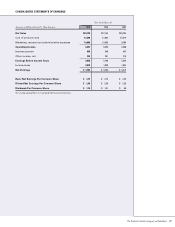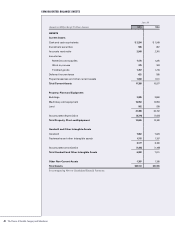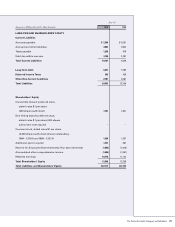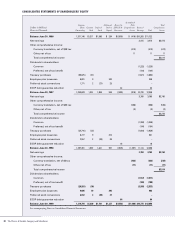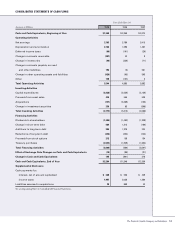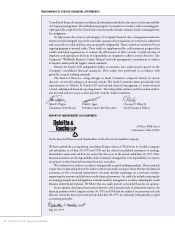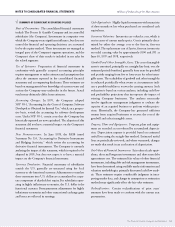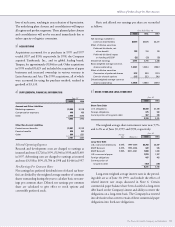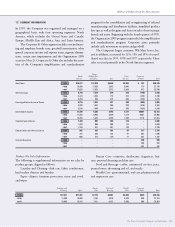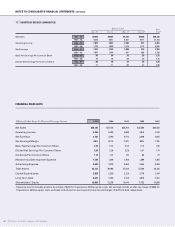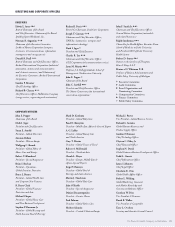Proctor and Gamble 1999 Annual Report Download - page 40
Download and view the complete annual report
Please find page 40 of the 1999 Proctor and Gamble annual report below. You can navigate through the pages in the report by either clicking on the pages listed below, or by using the keyword search tool below to find specific information within the annual report.
NOTES TO CONSOLIDATED FINANCIAL STATEMENTS (CONTINUED)
The fair value of the long-term debt was $6,517 and
$6,412 at June 30, 1999 and 1998, respectively. Long-term
debt maturities during the next five years are as follows:
2000 – $467; 2001– $368; 2002 – $453; 2003 – $1,103; and
2004 – $1,190.
6RISK MANAGEMENT ACTIVITIES
The Company is exposed to market risk, including changes in
interest rates, currency exchange rates and commodity prices. To
manage the volatility relating to these exposures, the Company
nets the exposures on a consolidated basis to take advantage of
natural offsets and enters into various derivative transactions for
the residual portion pursuant to the Company’s policies in areas
such as counterparty exposure and hedging practices. The finan-
cial impacts of these hedging instruments are offset in part or in
whole by corresponding changes in the underlying exposures
being hedged. The Company does not hold or issue derivative
financial instruments for trading purposes.
Interest Rate Management
The Company’s policy is to manage interest cost using a mix
of fixed and variable rate debt. To manage this mix in a cost-
efficient manner, the Company enters into interest rate swaps,
in which the Company agrees to exchange, at specified inter-
vals, the difference between fixed and variable interest
amounts calculated by reference to an agreed-upon notional
principal amount. These swaps are designated to hedge under-
lying debt obligations. For qualifying hedges, the interest rate
differential is reflected as an adjustment to interest expense
over the life of the swaps.
Certain currency interest rate swaps are designated as
hedges of the Company’s related foreign net investments.
Currency effects of these hedges are reflected in the accumu-
lated other comprehensive income section of shareholders’
equity, offsetting a portion of the translation of the net assets.
The following table presents information for all interest
rate instruments. The notional amount does not necessarily
represent amounts exchanged by the parties and, therefore, is
not a direct measure of the Company’s exposure to credit risk.
The fair value approximates the cost to settle the outstanding
contracts. The carrying value includes the net amount due to
counterparties under swap contracts, currency translation
associated with currency interest rate swaps and any marked-
to-market value adjustments of instruments.
June 30
1999 1998
Notional amount $1,614 $2,149
Fair value $7 $7
Carrying value 15 28
Unrecognized loss (8) (21)
Although derivatives are an important component of the
Company’s interest rate management program, their incre-
mental effect on interest expense for 1999, 1998 and 1997 was
not material.
Currency Rate Management
The Company manufactures and sells its products in a number
of countries throughout the world and, as a result, is exposed to
movements in foreign currency exchange rates.
The major foreign currency exposures involve the
markets in Western and Eastern Europe, Asia and Mexico.
The primary purpose of the Company’s foreign currency
hedging activities is to protect against the volatility associated
with foreign currency purchases of materials and other assets
and liabilities created in the normal course of business.
Corporate policy prescribes the range of allowable hedging
activity. The Company primarily utilizes forward exchange
contracts and purchased options with maturities of less than
eighteen months.
In addition, the Company enters into certain foreign
currency swaps to hedge intercompany financing transactions,
and utilizes purchased foreign currency options with maturi-
ties of generally less than eighteen months and forward
exchange contracts to hedge against the effect of exchange rate
fluctuations on royalties and foreign source income.
Gains and losses related to qualifying hedges of foreign
currency firm commitments or anticipated transactions are
deferred in prepaid expense and are included in the basis of the
underlying transactions. To the extent that a qualifying hedge
is terminated or ceases to be effective as a hedge, any deferred
gains and losses up to that point continue to be deferred and
are included in the basis of the underlying transaction. All other
foreign exchange contracts are marked-to-market on a current
basis, generally to marketing, research and administration
expense. To the extent anticipated transactions are no longer
likely to occur, the related hedges are closed with gains or losses
charged to earnings on a current basis.
36
The Procter & Gamble Company and Subsidiaries



